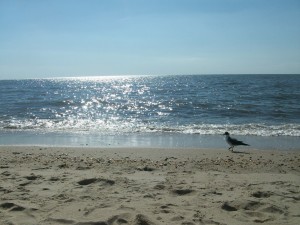Plastic is a part of our everyday lives. We carry our groceries in it, it packages all of our food, we drink water out of it and it helps our food stay fresh for a longer amount of time! Unfortunately, plastic also takes from five hundred to one thousand years to biodegrade. It is estimated that worldwide, up to one trillion plastic bags are used annually and approximately eight million metric tons of plastic waste end up in the world’s oceans each year (Schwartz, NY Times). Environmental engineering professor Jenna Jambeck says that this is the equivalent to “five plastic grocery bags filled with plastic for every foot of coastline in the world”. Because single use plastic bags are lightweight, the wind often blows them out of trash cans, garbage trucks and landfills, and the bags eventually reach water sources like rivers, streams and oceans. The bags then pollute fresh water, or are consumed by fish, turtles and whales in the ocean, which disrupts the food chain. In a county not very far from the Atlantic Ocean, it is important to consider how plastic bags have and will continue to impact marine wildlife, our precious “Jersey Shore”, and the beautiful state parks and recreation areas that thrive in our county.


When plastic bags reach water sources, they do not decompose. Instead, they break apart into tiny bits of plastic that become coated with toxins like polychlorinated biphenyls, known as PCBs (NY Times). PCBs were actually banned in the United States in 1979 because of their impact on human and environmental health, but unfortunately, they still exist today and end up not only contaminating marine wildlife, but the seafood we eat. Fish, turtles and whales mistake the plastic debris coated in PCBs for food, and end up consuming them. Because of the marine food chain, the animals that eat the plastic are consumed by larger marine animals, and then those marine animals are consumed by even larger marine animals, which are eventually consumed by humans. This means that these toxins can end up in the bodies of humans, which is unhealthy for our species.

Chelsea Rochman and co-authors conducted a study regarding anthropogenic debris – environmental pollutants originating in human activity, like plastic – in seafood that is consumed by the human population. The researches bought fresh oysters, anchovies, salmon, striped bass and other commonly consumed fish from fishermen in both Indonesia and California who sold their seafood for human consumption. The researchers then examined the digestive tract of each individual fish, and what they found was shocking. From the fish purchased in California, anthropogenic debris was found in 25% of individual fish and 55% of all species (Rochman). Anthropogenic debris has horrible effects on fish such as cellular necrosis (the death of some or all cells in an organ or tissue), tumors and indigestion. What is especially worrisome about this is that one-quarter of the fish that humans consume actually contain this hazardous debris. No research has been conducted to discover if there is direct causation between anthropogenic debris and health risks for humans, but “anthropogenic marine debris may cause physical harm to humans when debris is ingested via seafood”, and if hazardous chemicals transfer to animals through the process of indigestion, it has the potential to increase the likelihood of hazardous chemicals in humans that consume the sick marine animal (Rochman). The cyclical process of plastic bag pollution has significant potential to harm the health of humans, and this should not be ignored.

In terms of economics, single use plastic bag pollution costs large sums of money to clean up. Last year alone, United States taxpayers spent nearly eleven billion dollars cleaning up litter across the United States, which is ten times more than it costs for trash disposal (NCDPS). San Jose, in California, estimated an annual loss of one million dollars due to plastic bag related repairs in their recyclables stream. Because single-use bags are lightweight and small, they easily jam up recycling machinery which requires pricy repairs (CAW Recycles). Not only that, but the city of San Diego in California spent approximately $160,000 taxpayer dollars annually cleaning up plastic bag litter (Energy Center Org). In 2015, Somerset County removed 36,650 pounds of litter from county roads. This was funded by an $81,607.51 grant from New Jersey Clean Communities program, proving that roadside cleanup and litter management is not free (Somerset County, Talking Trash).


In communities and cities that have already implemented the plastic bag ban and fee, there was only a short-term increase in baggage cost for retailers due to the switch from plastic to paper bags, since paper bags are more expensive. However, this has statistically lowered over time, and cities like San Jose and San Francisco have reported that the ban had “no sustained negative impact to retailers” (Energy Center). It was estimated that after implementing the ban, it would cost households an estimate of $7.70 to purchase reusable bags, whilst accounting for the ten-cent fee. More importantly, this policy will not negatively impact the economically disadvantaged. In local Californian cities that have implemented the plastic bag ban, they have also established exemptions or subsidies for low-income program participants.

Communities in California and their surrounding natural environment sustained many positive benefits after implementations of plastic bag bans. For example, only one year after plastic bag bans were implemented in San Jose, storm drain systems became 89% cleaner, streets became 59% cleaner and creeks became 71% cleaner (Squarespace). One year after the plastic bag ban was implemented in San Francisco, beach cleanups showed that the average number of plastic bag collected per cleanup event declined from 65 per cleanup in 2009 to just 6 bags per cleanup in 2013 (Squarespace). These statistics show a significant decrease in litter and plastic bags, and a significant increase in cleanliness on beaches, creeks and streets.

Our county takes pride in its beautiful natural areas and parks such as Natirar, Leonard Buck Garden, the Great Swamp, Little Brook Sanctuary and Washington Valley, and both time and money can be saved by reducing the amount of litter that pollutes creeks and rivers in the first place! It is important to consider that communities spend so much time and money cleaning up trash because a clean community is perceived as a safe place to live, where citizens care about the place that they work and raise children. It is clear that having clean communities is extremely important, but it is possible to have a clean place to live without spending so much money on litter cleanup. Plastic bag bans open up opportunities to direct the money and taxpayer dollars that would have originally been used for litter clean-up towards something else.


In terms of energy and waste, before and after studies have indicated that in California, bag bans decreased energy usage by 74,000 joules and reduced solid waste by 595,248 pounds (Energy Center). It also reduced CO2 emissions by 6,418 tons, which is comparable to the annual energy use from 589 homes or 1,186 passenger vehicles (AASHE). Even though the numbers are small, they are externalities that can be reduced.
Cities of San Jose, Santa Monica and Los Angeles County provided compounded statistics from before and after the plastic bag bans. Before the bans, 75% of plastic bags used at stores were single use plastic bags, 17% of citizens didn’t use a bag, 5% used reusable bags and 3% used paper bags. After the bag ban was implemented, 45% of citizens used reusable bags, 39% didn’t use a bag and 16% used paper bags (Squarespace). This research shows that the plastic bag ban increased reusable bag usage by 40%, and caused 22% more people to not use a bag if they didn’t need one.
